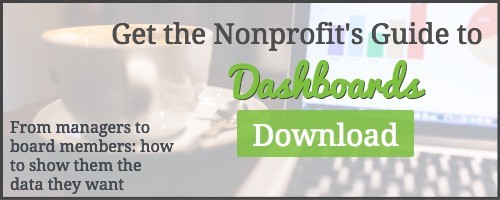Managing finances for a nonprofit organization means getting visibility into how your organization is achieving its mission. Program managers, CFOs, CEOs, and board members all need insight into different aspects of the financial and operational data to make the right decisions. How can you be sure every decision maker on every level is equipped with the right tools to gain insight and act on data?
We’ve talked about the necessary KPIs (key performance indicators) you should be tracking for your nonprofit organization. We’ve walked through some important dashboard components for solving the visibility problem. Now, it’s time to talk about who is looking at these dashboards and what they want to see.
This is a huge factor to remember when it comes to creating reports and dashboards: who is the viewer? Is this for a program manager or the CEO? Will you be presenting to your CFO or to the board?
Ideally, an organization should have a number of different dashboards to enable each dashboard to have the information and KPIs that are important to that specific viewer.
A program manager will need to see something drilled down and specific to their program (like the number of beds) whereas your board wants to look at things from a higher level.
Let’s take a look at who is looking at a dashboard and what they want to see.
Program Manager Dashboard
A nonprofit program manager will want to see information that is relevant to their job. For example, how much of each program’s grant or contract has been spent down (if they are grant or contract funded)? They need to look at program-specific metrics such as the number of used and open beds or how many meals served. They will also want to see not just the number of beds, but the missed revenue due to the open beds. In addition to the snapshot and at-a-glance data, a program manager’s dashboard should also consist of trend data.
CFO Dashboard
On a CFO dashboard, there are some recommended KPIs to measure. First, a CFO will want to look at actual to budget variance. This should be consolidated for the organization as a whole and for each program and/or grant. Next, the CFO should look at cash basis summaries as a trend graph. Review the cash balances in the bank and cash balances by contract, grant, program, and so on. The CFO should also be able to see Accounts Payable and Accounts Receivable balances.
Board Member Dashboard
Any dashboard a board member will be viewing should be as “English language” as it can be and shown at a very high level. It should highlight financial data such as the Quick Ratio. The Quick Ratio shows how much the organization’s assets exceed its liabilities. The higher the ratio, the more dollars are available to pay off its bills, and the healthier an organization is. So, a Quick Ratio of 1 would mean the organization has just enough liquid assets to pay its bills.
In addition to financial information, the dashboard should also include key metrics showing how the organization is achieving its mission and impact.
CEO Dashboard
A CEO dashboard should consist of some elements of the CFO and board metrics mentioned above, combined with a higher level view of the mission metrics such as a program manager would view, but on a consolidated level.
Why do the right dashboards even matter?
Dashboards are valuable tools for nonprofit finance teams. These visual aids give quick insight and inspire empowered decision making for everyone from program managers to board members. The long-term growth and sustainability of your programs rely on the operational foundation of a strong business process, healthy systems, and access to actionable data to support smart decisions.
Probably one of the most valuable aspects of dashboards is the transparency they offer. If you want to secure and keep donors on board with your organization you’ve got to be transparent.
Transparency is a non-negotiable best practice for leading nonprofits today. When you can quickly and accurately ‘know and show’ what funders want to see, you instill a sense of confidence that their discretionary investments are well-managed. You have an edge over other agencies competing for those same dollars.
Take control of your nonprofit financial management
Ready to take control of the financial processes in your organization? This won’t happen with disparate data pulled from manual processes like spreadsheets. You need real-time data, not just a monthly financial report. Learn how to create the right dashboards for the right people with our Nonprofit’s Guide to Dashboards.


